Accenture Tower vs One Liberty Place Building


Comparing the Accenture Tower and the One Liberty Place Building is an interesting exercise, because even though they are located in different cities (Chicago, IL and Philadelphia, PA), both were designed by Murphy/Jahn Architects and finished within in the same year. This gives us the chance to see how the same architect's ideas were expressed in different urban contexts almost simultaneously.
Height & Size
These two towers present an interesting contrast in their proportions. The Accenture Tower rises higher at 587ft (179m), while the One Liberty Place Building reaches 0ft (m). However, the One Liberty Place Building accommodates more floors with 61 levels above ground, compared to 42 floors in the Accenture Tower.
This suggests different approaches to interior space design. The Accenture Tower has an average floor-to-floor height of approximately 4.3m, while the One Liberty Place Building has more compact floors averaging around 0m each. The taller building's more generous floor heights might indicate grander interior spaces, higher ceilings, or different programmatic requirements.
These different proportions likely reflect the specific needs each building was designed to serve, whether driven by zoning regulations, client requirements, or the intended use of the spaces within. The contrast shows how architects can achieve different spatial experiences even when working with similar overall building scales.
Architectural Style
Both the Accenture Tower and the One Liberty Place Building were designed in line with the aesthetic conventions of the Postmodernism style.
At the time, this style was at the height of its popularity. So Murphy/Jahn Architects followed what was in many ways expected at the time, producing designs that fit comfortably within contemporary architectural norms rather, than breaking with convention.
Uses
Both the Accenture Tower and the One Liberty Place Building were designed to serve as commercial towers, and that has remained their main use since their completion, serving similar roles in the urban fabric.
The One Liberty Place Building also provides 779 parking spaces.
Structure & Facade
The two towers rely on different structural systems, reflecting distinct engineering strategies.
The Accenture Tower uses a Frame structural system, which relies on a regular grid of columns and beams to sustain its weight, while the One Liberty Place Building uses a Framed Tube In Tube system, that combines a strong central core with a perimeter tube of columns.
Yet, when it comes to their facade, they both employed the same solution, a Curtain Wall facade.
A curtain wall is a non-load-bearing facade hung from the structural frame. It is anchored to floor slabs and transfers only its own weight and wind loads, allowing for sleek, glassy exteriors.
| Accenture Tower | One Liberty Place Building | |
|---|---|---|
| Murphy/Jahn Architects | Architect | Murphy/Jahn Architects |
| 1984 | Construction Started | 1985 |
| 1987 | Year Completed | 1987 |
| Postmodernism | Architectural Style | Postmodernism |
| Commercial | Current Use | Commercial |
| 42 | Floors Above Ground | 61 |
| 148,640 m² | Usable Area (m²) | 111,483 m² |
| Frame | Structure Type | Framed Tube In Tube |
| Steel | Vertical Structure Material | Steel |
| Concrete And Steel | Horizontal Structure Material | Concrete |
| No | Facade Structural? | No |
| Aluminum, Glass, Steel | Main Facade Material | Glass, Steel |
| Cohen Barreto Marchertas | Structural Engineer | Lev Zetlin Associates |
| IL | State | PA |
| Chicago | City | Philadelphia |
| 500 West Madison Street | Address | 1650 Market Street |